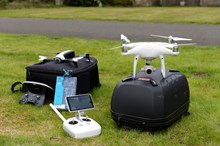31 August, 2018
DRONES AND WILDLIFE: Operators warned against misuse

Issued on behalf of the Partnership for Action Against Wildlife Crime (PAW) Scotland
Specialists have warned that those operating drones could be causing stress to wildlife.
Drones have become increasingly popular for taking aerial photographs and for conservation work, such as scientific surveys. But your drone could put you on the wrong side of the law, if you fly it too close to wildlife. The Partnership for Action Against Wildlife Crime (PAW) Scotland says there are some important do’s and don’ts to avoid disturbing protected species.
Yesterday (Thursday, 30 August) at Battleby in Perthshire, Scottish Natural Heritage (SNH) staged a demonstration of the best use of drones, with experts on hand to explain how to avoid disturbing wildlife. PAW Scotland have issued advice for drone operators, with a reminder that people must have a license for photographing some particularly vulnerable birds.
The law protects the nests of wild birds from any form of damage or obstruction, including even our most common garden birds. Some birds, like the golden eagle and mammals, like dolphins and whales, are protected from disturbance at any time, not just within the breeding season.
Andy Turner, Wildlife Crime Officer with SNH, says, “There have been several incidents involving drones disturbing seals at designated haul-out sites. Likewise. there have been anecdotal reports of drones being used to film sea bird colonies and raptors. While the footage from drones in these circumstances can be very spectacular, the operator must be mindful of the effect on wildlife. Birds of prey in particular can see drones as a threat and act aggressively towards them, causing both injury to themselves and damage to the drone. We would encourage anyone wishing to film wildlife with a drone to contact SNH for advice and, if necessary, apply for a licence.”
PC Charlie Everitt, of the UK National Wildlife Crime Unit, says: “Wildlife crime is treated seriously by Police Scotland and can result in a criminal record for offenders. Breeding wild birds, dolphins, whales and seals are all protected from harassment or disturbance by law that currently imposes fines up to £5,000 or imprisonment for up to six months on those who break it. Irrespective of whether the offender is an egg collector, boat skipper or drone operator, the possible sentences are the same. It is therefore essential that drone operators understand the law, research the legal status and behaviour of any wildlife they intend to film, and obtain the necessary licences to keep on the right side of the law.”
Detailed guidance on wildlife photography and licensing can be found on the PAW Scotland website at www.PAW.Scotland.gov.uk
ENDS
MEDIA QUERIES
For more information, contact SNH media relations & PR officer, Vicki Mowat, on 0131 316 2659 or vicki.mowat@snh.gov.uk or the main SNH press office on 0131 316 2655.
Pictures: Please credit Lorne Gill/SNH. Pictures show 1) a selection of types and sizes of drones available; 2) Charlie Everett from NWCU speaking about drone use, how to stay within the law, and avoid disturbing wildlife; and 3) a picture taken from a drone at the Battleby. All pictures are from an event at the Battleby SNH office near Perth, during a Marine Wildlife Crime Sharing Good Practice event on 30 August.
NOTES TO EDITORS
PAW Scotland is the Partnership for Action Against Wildlife Crime in Scotland, including the police, land managers, conservationists and government agencies, working together to fight wildlife crime.
Scottish Natural Heritage is the government's adviser on all aspects of nature and landscape across Scotland. Our role is to help everyone understand, value and enjoy Scotland's nature now and in the future. For more information, visit our website at www.nature.scot . SNH media is also now on Twitter at www.twitter.com/nature_scot
Contact information
- Name
- NatureScot Media
- Telephone
- 0131 316 2655
- media@nature.scot
NatureScot is Scotland's nature agency. We work to enhance our natural environment in Scotland and inspire everyone to care more about it. Our priority is a nature-rich future for Scotland and an effective response to the climate emergency. For more information, visit our website at www.nature.scot or follow us on X at https://x.com/NatureScot
’S e NatureScot buidheann nàdair na h-Alba. Bidh sinn a’ neartachadh àrainneachd na h-Alba agus a’ brosnachadh dhaoine gu barrachd suim a chur ann an nàdar. Tha e mar phrìomhachas againn gum bi nàdar na h-Alba beairteach agus gun dèilig sinn gu h-èifeachdach le èiginn na gnàth-shìde. Tha an tuilleadh fiosrachaidh aig www.nature.scot no air X aig https://x.com/NatureScot




